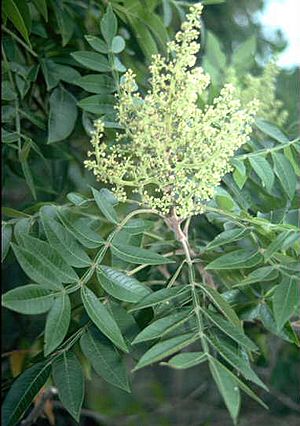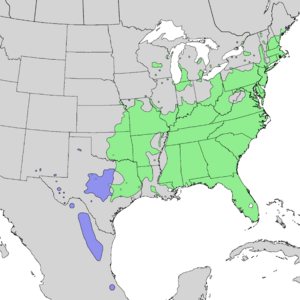Rhus copallinum facts for kids
Quick facts for kids Rhus copallinum |
|
|---|---|
 |
|
| Conservation status | |
| Scientific classification | |
| Genus: |
Rhus
|
| Species: |
copallinum
|
| Varieties | |
|
R. c. var. copallinum |
|
 |
|
| Native range of Rhus copallinum var. copallinum (green) & var. latifolia (blue) |
|
| Synonyms | |
|
Rhus copallina |
|
The winged sumac, also known as shining sumac or flameleaf sumac, is a type of flowering plant. Its scientific name is Rhus copallinum. It belongs to the cashew family and grows naturally in eastern North America.
This plant is a deciduous tree, which means it loses its leaves in the fall. It can grow to be about 3.5 to 5.5 meters (11 to 18 feet) tall. It also spreads out about the same width, forming a round shape. A young tree, around five years old, will be about 2.5 meters (8 feet) tall.
What Does Shining Sumac Look Like?
Shining sumac is often planted in gardens and parks. It's great for natural areas because its roots spread underground. This helps it form thick, bushy patches. These patches provide good cover for birds and other wildlife.
People love this plant for its beautiful leaves. They are a shiny dark green during the summer. In the fall, they turn a bright orange-red color. You can often see these colorful trees growing along highways. They grow easily in places where the ground has been disturbed.
In the summer, the tree grows tiny, greenish-yellow flowers. These flowers grow in tight bunches at the ends of the branches. After the flowers, bright red clusters of berries appear. These berries stay on the tree into winter and are a food source for wildlife.
The flowers are yellow and bloom in the summer. The fruit attracts birds and doesn't make much mess. The berries stay on the tree for a long time and look very pretty.
The bark of the shining sumac is thin and can be easily damaged. As the tree grows, its branches might droop. Sometimes, branches need to be trimmed so people or cars can pass underneath. The tree naturally wants to grow with many trunks, but it can be trained to have just one main trunk. It does not have any thorns.
How Shining Sumac Is Used
This tree can be planted in large pots or raised garden beds. It's a good choice for planting around parking lots or in the middle sections of highways. It's also used to help restore land that has been damaged.
Rhus copallinum can handle salty air, like near the ocean. It can also grow in tough soils, such as rocky soil or soil that has a lot of a mineral called serpentine.
The shining sumac grows well in full sun or partial shade. It can grow in many types of soil, including clay, loam, and sand. It likes soil that drains water well. It can also handle slightly alkaline or acidic soil. This tree is very good at surviving dry periods.
The small, berry-like fruits are a bit sour but can be eaten. They are full of vitamin A. Wildlife, like deer, eat the twigs of the tree. The berries can also be used to make a drink that tastes a bit like lemonade. Even some lemurs, like Coquerel's sifakas, eat the leaves of this plant.
See also
 In Spanish: Rhus copallinum para niños
In Spanish: Rhus copallinum para niños





